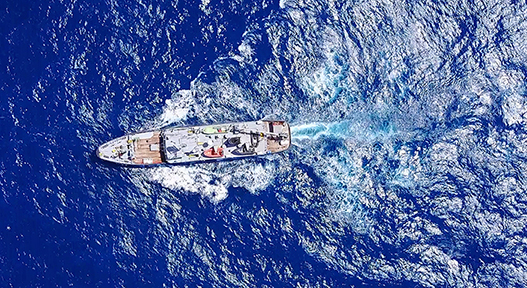 |
News of the National Geographic 'Pristine Seas' team 5-week expedition to the Tristan da Cunha archipelago conducted in partnership with the Tristan Government and the Royal Society for the Protection of Birds in January and February 2017.
Reception at the Royal Geographical Society on 27th July 2017
Reception and film premier held at the Royal Geographical Society
Report from Richard Grundy, with additional photos from Peter Millington
A large attendance of Tristan Government representatives, Tristan da Cunha Association members, scientists and other Tristan da Cunha stakeholders met at the Royal Geographical Society at 6pm on 27th July 2017 to attend an evening programme titled 'In Celebration of Tristan da Cunha'.
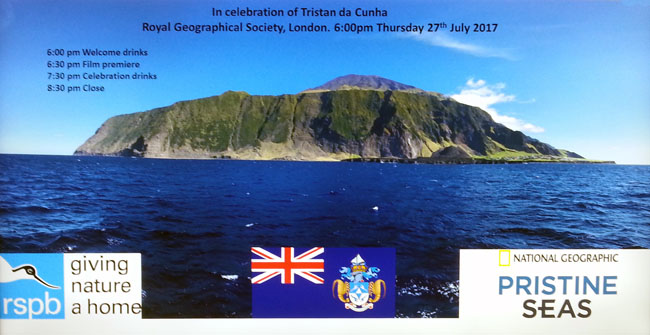
Opening slide shown in the RGS Lecture Theatre
Hosted by the National Geographic Society and the RSPB, the evening's MC was Paul Rose who was the leader of the Pristine Seas Expedition to Tristan da Cunha held in January and February 2017.
The evening celebration started with welcome drinks in the famous RGS Map Room. Many guests had attended the workshop to plan Tristan's Blue Belt Commitments held the same day at the Foreign and Commonwealth Office in Whitehall and here they greeted friends and colleagues gathered for the unique event.
Proceeding to the prestigious RGS Ondaatje Theatre, the scene of many famous geographical presentations in the past, Paul Rose welcomed everybody and outlined the huge success of the Pristine Seas Expedition.
Pristine Seas Expedition Leader Paul Rose giving his introductory speech of welcome
Following Paul, the large audience was addressed by the enthusiastic Jenn Caselle who was Chief Scientist of the Pristine Seas Expedition. Jenn is from the Marine Science Institute, University of California, Santa Barbara (UCSB) and made those present aware of the brilliant work the expedition was able to carry out in excellent weather conditions which allowed the full scientific programme to be carried out.
Paul also introduced Jonathan Hall who is Head of UK Overseas Territories at the Royal Society for the Protection of Birds (RSPB). Jonathon was also a member of the Pristine Seas Expedition where he worked alongside members of the Tristan da Cunha Conservation and Fisheries Departments led by Trevor and James Glass, the latter present this evening.
There followed the premiere of the National Geographic Film which held the audience spellbound and afterwards was followed by spontaneous applause. The photography was stunning, particularly the drone photos of the Tristan da Cunha Islands, especially those approaching the Tristan Settlement and those hovering over Nightingale Island's High Ridge. Many sequences were taken under water and the whole showcased the amazing land and sea scientific work carried out by the expedition team. It was also fitting that the Tristan community was set at the heart of the film, with Heads of Department Dawn Repetto (Tourism), James Glass (Fisheries) and Trevor Glass (Conservation) joining Chief Islander Ian Lavarello in being interviewed to promote the island as it seeks a sustainable future in harmony with its special environment, now recognised by the Gough and Inaccessible Islands World Heritage Sites.
A copy of the 35 minute film will be sent to Tristan da Cunha and it is hoped also to show it at a future Tristan Association Annual Gathering. It is likely to be broadcast across the world and will no doubt play a pivotal role in making a wider audience aware of the very special Tristan da Cunha Islands.
Tristan Administrator Sean Burns addresses the gathering
Once applause for the film at last died down, Paul Rose introduced Sean Burns who thanked National Geographic and RSPB for organising the splendid evening as well as all those attending from the UK and overseas. Sean reported on a successful three days of workshops, two at the RSPB's Bedfordshire HQ held earlier in the week, leading up to the main Blue Belt Workshop at the FCO during 27th July, all working towards the Tristan da Cunha Government's commitment to establishing its own version of a Marine Conservation Area by 2020. Sean emphasised how successful Tristan already was in achieving Marine Stewardship Award for its sustainable lobster fishery and its partnership with the RSPB and other agencies to monitor and protect its precious wildlife habitat. He outlined embryo plans to extend studies to ensure that Tristan's marine ecosystem would be protected and enhanced in the future by working together.

Celebration drinks and delicious food being enjoyed in the RGS Main Hall
All then gathered in the main RGS foyer where we were treated not only to a choice if wines and soft drinks, hot and cold food served by staff, but were also presented with a copy of the National Geographic Pristine Seas, RSPB and Tristan da Cunha Government Expedition Report titled 'Ecosystem Assessment of the Tristan da Cunha Islands'. This lavishly produced, spiral-bound publication is packed with beautiful photographs, maps, tables, statistics and report and is a most welcome addition to the bibliography of the islands.
Overall, it was a privilege to attend this special event 'In Celebration of Tristan da Cunha' at what is regarded as the most important geographical venue in the world. It was a special night for many Tristan da Cunha Association members who attended, including former Administrator Mike Hentley, now Vice-Chair of the association and islander Hazel Carter with her husband Barry. We were all most grateful to be invited and thank the organisers for a splendid evening. Looking around the packed Main Hall we hope many of the young scientists getting to know Tristan for the first time will join the Association and attend our own Annual Gatherings held in Southampton on the Saturday after Easter each year.
Video of 'Pristine Seas' Work at Tristan
Andy Schofield, RSPB, introduced a short video at the Association's 2017 Annual Gathering of stunning footage shot during the 'Pristine Seas' expedition to the Tristan da Cunha archipelago. A rough cut version of the film had previously been shown to islanders and Tristan and was favourably received.
Click on the image to view the video. Alternatively, you can view it on Youtube at:
https://www.youtube.com/embed/rQwLBQ3hMCk
Tristan waters provide refuge for near-threatened blue sharks
Report and photos from Chris Thompson
Blue sharks (Prionace glauca) are one of the great ocean wanderers. These slim, graceful sharks with large eyes and brilliant blue backs are known to make journeys of up to 9,200km (5,700 mi) with some individuals making multiple trans-Atlantic crossings.
Unfortunately these incredible travellers are at great risk from modern fishing practices. They are the most heavily fished shark in the world with many millions taken annually. They are predominantly caught as bycatch as their meat is little valued. However, their large scythe-shaped fins are highly prized in the fin trade and thus they are often taken for their fins—their carcasses discarded at sea.

An adult blue shark inspects the camera on one of the mid-water camera rigs
While their IUCN status is near threatened, a reduced catch rate of 60-80 percent has been reported in recent years and the available data is considered inadequate to accurately assess global population declines.
The footage collected on our pelagic cameras, however, suggests that the waters of Tristan da Cunha may provide a refuge for these gentle giants. As part of the Pristine Seas science program we have been using remote cameras known as mid-water stereo-BRUVS (baited remote underwater video systems) to non-destructively sample the pelagic wildlife found in the open ocean. These rigs are allowed to drift in offshore waters for two hours per deployment, allowing us to identify, count, and measure the pelagic wildlife occupying these waters including sharks, whales, dolphins, turtles, tunas, and forage fish. These unique camera systems allow a glimpse into one of the most understudied habitats on the planet: the open ocean.
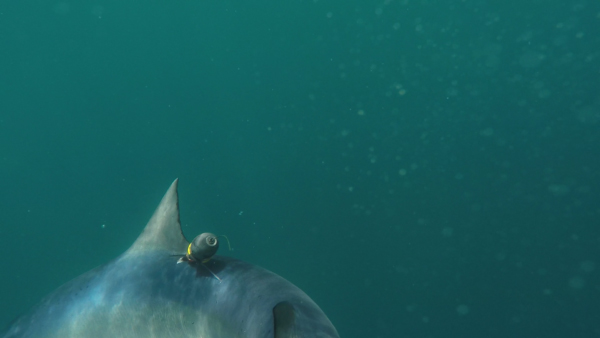
A tagged adult female blue shark swims away; this tagging will allow the science team
to learn more about movements of the sharks around Tristan waters.
While their IUCN status is near threatened, a reduced catch rate of 60-80 percent has been reported in recent years and the available data is considered inadequate to accurately assess global population declines.
The footage collected on our pelagic cameras, however, suggests that the waters of Tristan da Cunha may provide a refuge for these gentle giants. As part of the Pristine Seas science program we have been using remote cameras known as mid-water stereo-BRUVS (baited remote underwater video systems) to non-destructively sample the pelagic wildlife found in the open ocean. These rigs are allowed to drift in offshore waters for two hours per deployment, allowing us to identify, count, and measure the pelagic wildlife occupying these waters including sharks, whales, dolphins, turtles, tunas, and forage fish. These unique camera systems allow a glimpse into one of the most understudied habitats on the planet: the open ocean.
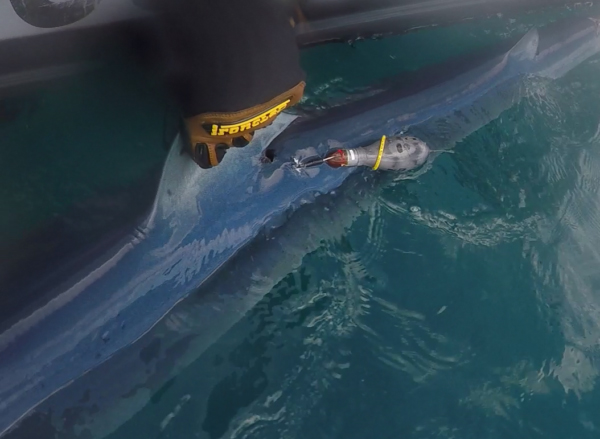
An adult female blue shark is fitted with a tag by the Pristine Seas science team
During this expedition by far the most prevalent species we have encountered on the footage is the blue shark. Tristan da Cunha's waters harbour more blue sharks than we have seen in any of the other locations we have sampled all over the world, and what is most interesting is the composition of the blue shark population here.
We are seeing only large females and very small juveniles, suggesting that the waters of Tristan da Cunha might be a blue shark nursery ground with large females traveling here to give birth; the lack of intense fishing effort seen in other parts of the world providing a sanctuary for the pups to grow in peace before undertaking migrations of their own.
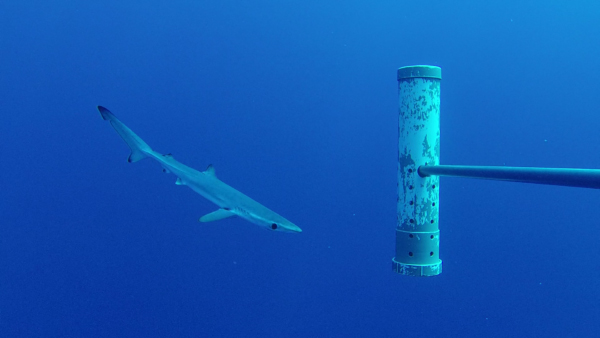
A small blue shark pup, as seen in the footage from a pelagic camera deployment off Tristan da Cunha
In addition to the sharks seen on camera, the team has also managed to tag three large female blue sharks. This will enable us to learn more about the movements of these animals and see whether they are resident to Tristan waters or if they make the long migrations their kin are known to undertake.
Blue sharks may not be the only sharks using Tristan waters as a nursery ground, a single small Porbeagle shark pup (Lamna nasus), a smaller relative of the Great White and Mako known predominantly from the population surrounding the U.K., was also recorded on camera. At approximately 60 cm (2 ft), this observation is a first for Tristan waters and suggests it was likely born in these waters.

An adult blue shark inspects the bait canister on one of our mid-water camera rigs
It may be that the very fact of Tristan being the most remote inhabited island in the world is what provides the protection these mothers and their young need from the fishing fleets which they are so vulnerable to.
If going forward these waters continue to be protected from offshore fishing it could provide a much needed refuge for these sharks and other pelagic species.
St Mary's School party's day with expedition team
St Mary's School's day with the Pristine Seas Expedition TeamReport and photos from Victoria Stapleton |
|
| St Mary's School pupils with Pristine Team members aboard SVS Grenville | |
|
On Thursday 2nd February 2017, St Mary's School was visited by Paul Rose and his team from National Geographic's Pristine Seas project. First thing, Paul Rose explained to the children what the project was all about and showed some of the amazing footage they had taken underwater and above water on Tristan, Inaccessible, Nightingale and Gough Island. Everyone really enjoyed this and was amazed at the beautiful footage. After the presentation, the whole school went down to the beach and took some water samples and recordings with Jenny and Mia. Jenny explained how even though we can't see it, sometimes there are tiny pieces of plastic in the water that can harm our environment. Then it was time to go aboard the Grenville. Trevor and his team came to pick up the children, teachers and scientists and after three trips it was time to learn more about what Pristine Seas was doing. Captain Archie explained to the children how he navigated the ship and how the radar worked to stop the ship from crashing into Tristan. Next, they went down below and Alan showed everyone his deep underwater camera and some of the footage he had filmed. Chris also showed an underwater camera but his camera was designed for capturing pictures of marine life at approximately 10 metre depths. Mia, the seal specialist, showed the children how to catch seals without getting bitten and Tristan managed to catch a rare Andy seal. Jenny, the head scientist, explained how we can learn about invasive species like the Porgy by looking at what's inside their stomachs and in particular looking at the fish ear bones from the fish they eat. Dave, the diving medical officer, showed everyone the ship's own personal decompression chamber which is there to make sure the divers stayed healthy due to doing so many dives a day. It was very small but looked quite comfortable. After everyone returned back to the island, Paul Rose held a live Twitter event in the council chambers. Tristan, Dylan, Ryan and Kieran went as representatives to answer questions for the school children. Everyone had a fantastic day aboard the Grenville and all the children and teachers had a different favourite bit of the day. At the Friday presentation, National Geographic donated a lovely atlas to the school and all the islanders received a Nat Geo cap. Everyone is now looking forward to September when they return to show the full length film of the Tristan Islands Expedition. |
|
| Pristine Team members working with the pupils on the beach and on the ship. | |
 |
|
| More photos of the day aboard SVS Grenville | |
| Pupils arrive back at St Mary's School after their memorable day. | |
Expedition arrives back in Cape Town
Report from RSPB's Jonathon Hall
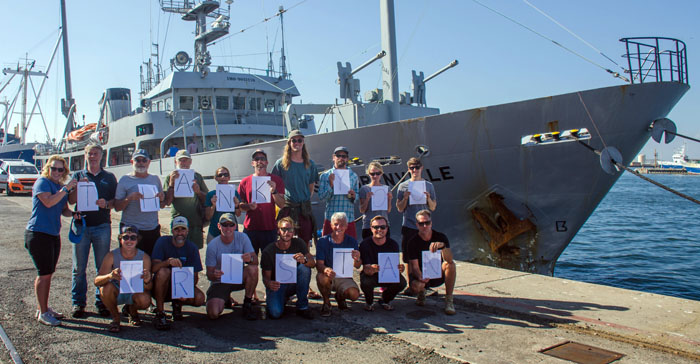
Photo from National Geographic's Dan Myers
shows expedition team members gathered alongside SVS Grenville
on 11th February 2017 at the end of the Pristine Seas Expedition to the Tristan da Cunha Islands
and spelling out 'THANK YOU TRISTAN'.
The National Geographic Pristine Seas and RSPB teams would like to thank everyone on Tristan for their enormously warm welcome, wonderful hospitality and vital assistance during the recent marine expedition. The team was able to complete over 100 dive surveys, 23 deep camera drops, and 30 offshore camera deployments, as well as attach satellite-tracking tags to seals, sharks and seabirds, which will all help inform which parts of Tristan’s marine zone are most important for different species.
We are now going to get cracking on finishing writing up the science results and editing the documentary film in time to hopefully premiere it on Tristan during the September changeover. Thank you also to everyone who attended the last night results presentation - we were extremely sorry to have to then leave after such an unforgettably brilliant visit!
Many thanks again for having us, and we look forward to continuing to support you to develop your own Tristan-led and science-based protections for your remarkable rich waters.
Tristan group spend day aboard SVS Grenville
Report and photos from Tristan Administrator Sean Burns
 |
|
| A Tristan RIB approaches the Pristine Seas National Geographic Expedition Ship SVS Grenville on 1st February 2017 to begin a circumnavigation of Tristan da Cunha by a local group. |
|
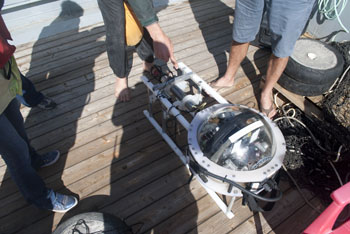 |
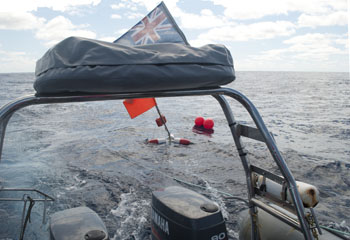 |
| Photos show: Left - a 'drop' camera being prepared for use under water; Right - pelagic cameras deployed as SVS Grenville continues its passage around Tristan da Cunha. |
|
 |
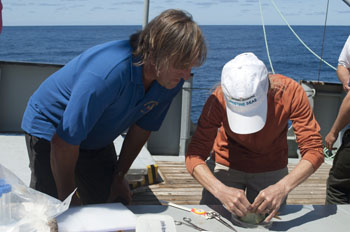 |
| Above and right: Scientists examining the invasive 'Porgy Fish' that were brought to Tristan aboard the Oil Platform PXXI in 2006. Head of Fisheries James Glass observes the examination in the photo right. | |
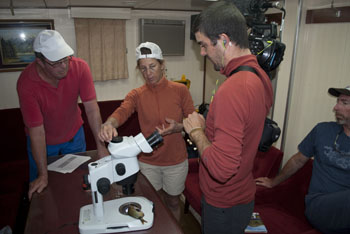 |
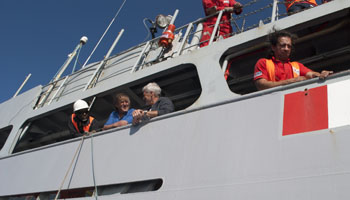 |
| Left: Factory Manager Erik Mackenzie learns about work in the Marine Science Lab.; Above: Head of Fisheries James Glass chats with Expedition Leader Paul Rose (both in centre). | |
 |
|
| View looking west showing Sandy Point (Tristan's eastern extremity) in the centre and Stoney Beach far left. | |
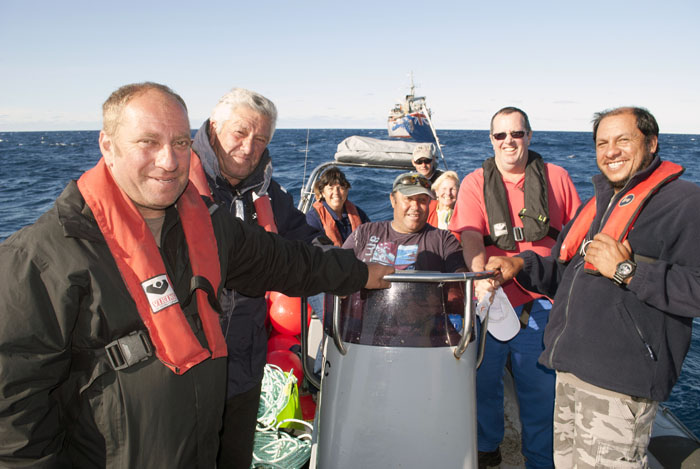 |
|
| Part of the Tristan party heading back to shore on the RIB Including Chief Islander Ian Lavarello, Island Councillors Terence Green, Iris Green and Warren Glass, Marina Burns, Factory Manager Erik MacKenzie and at the helm Head of Conservation Trevor Glass. |
|
Pioneering surfing off Inaccessible Island
Report from Expedition Leader Paul Rose

Ryan Jenkinson catches a wave. Photo by Roger Horrocks
If you are lucky, once in your lifetime you may get the chance to experience something no one else on this planet has ever previously experienced. For some it may be climbing a particular mountain, for others diving to the deepest, darkest corners of the oceans. Today, it was a few moments of bliss caught amidst our busy Pristine Seas expedition schedule to enjoy one of the things that made me fall in love with the ocean in the first place.
Sometimes a little R&R is just what the crew needs. Here, after a day filled with diving, two great pelagic camera deployments (with rare beaked whale footage and a hungry blue shark), bottom-of-the-ocean drop cam operations, seal counting on Nightingale, and a recovery of naturalist/adventurer Mike Fay from a botanical overnight on Inaccessible Island, a few of our explorers got a chance of a lifetime to experience a never-before-surfed wave.
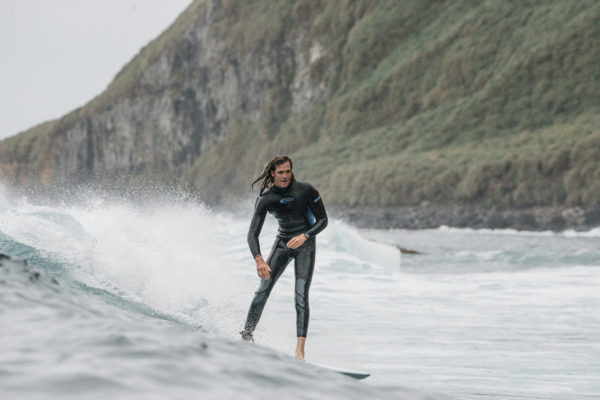
The wave drops and Chris Thompson comes into view. Photo by Roger Horrocks
Departure of SVS Grenville |
|
| The Pristine Seas National Geographic Expedition ship SVS Grenville departs Tristan for Cape Town 8-Feb-2017 |
|
National Geographic 'Pristine Seas' team visits the settlement
Report and photos from Kelly Burns
After a busy three weeks for all the National Geographic and RSPB team on the SVS Grenville, Friday 3rd February 2017 was a great day for all of the people onboard to come ashore to enjoy loads of fun activities.
The day was parted in to two as there was a crew swap around 13.30pm. There was a golf match in the morning hosted by Jody Squibb. At the same time there was a walk to the 1961 Volcano with tour guide Janine Lavarello. The volcano tour ended dropping into the Traditional Thatched house where there was a tour led by curator Shirley Squibb and live manikin Natalie Swain. There was also a tour of the fish factory.
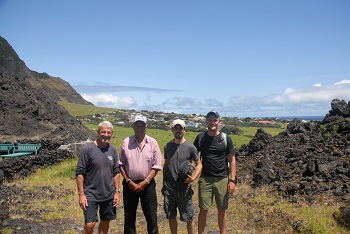 |
 |
| Team members visit Volcanic Park & the 1961 Volcano. |
At around 11.30am the film crew interviewed one of our islanders about the 1961 volcanic eruption. It was a fantastic interview between Harold Green and Paul Rose about the events that day all those years ago.
Also luckily the weather was pleasant enough for guides Simons Glass and Riaan Repetto to take a few people to Queens Mary's Peak.
 |
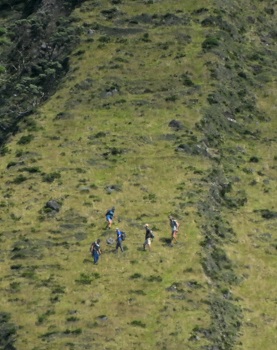 |
| Natalie Swain in traditonal Tristan costume at the Thatched House Museum. |
Returning down the mountain from a guided hike to Queen Mary's Peak. |
There was another golf match that afternoon for those who couldn't make it in the morning, and many enjoyed lots of delicious sandwiches and cakes at Café da Cunha.
Later that afternoon there was a presentation at the 'Prince Philip Hall' for the whole island displaying some of the research that has taken place over the past weeks. Also a brilliant short film was put together of some of the footage that they had captured. It was truly remarkable. The Administrator and Chief islander showed their gratitude to the teams effort and presented them with a few island gifts. Everyone also enjoyed refreshments and snacks before having a wonderful time at the Dance.
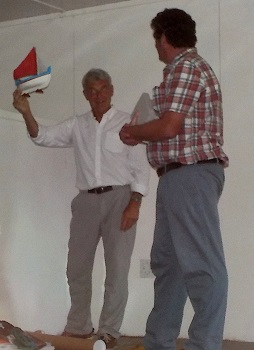 |
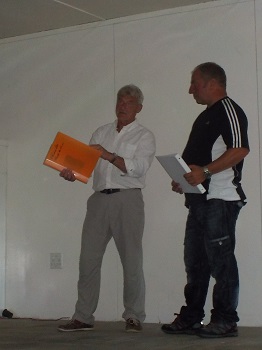 |
| Adminstrator Sean Burns presents a model Tristan longboat to expedition leader Paul Rose. | Paul Rose presents an album of old Tristan photos taken in the early 1900’s to Chief Islander Ian Lavarello. |
Saturday, some of the team and crew came ashore for some final shopping before heading over the Residency for a amazing Buffet. Also attending were Councillors and the Conservation and Fisheries Departments. Afterwards, the team all headed back to the Grenville to ensure their departure back to Cape Town at around 17.00pm.
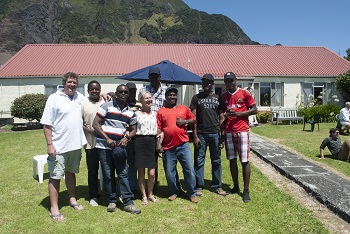 |
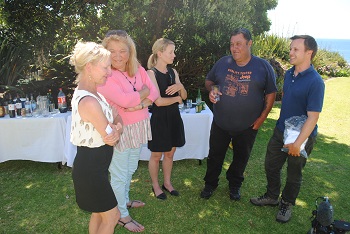 |
| Kenyan crew of the SVS Grenville with Administrator Sean Burns and his wife Marina. | Team members Alexandra Verville (centre) and Jonathan Hall (right) at the Adminstrator's reception. |
 |
|
| The expedition team and crew with Island Councillors and staff of the Conservation and Fisheries Departments. | |
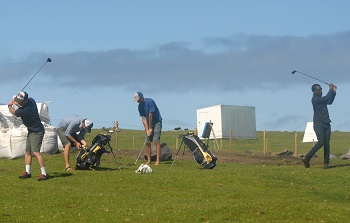 |
 |
| A match at the Tristan Golf Club. | SVS Grenville departing for Cape Town. |
Administrator Sean Burns' Remarks on the Visit
The National Geographic/RSPB visit was a huge success and I want to thank everyone involved. This includes those from Conservation and Fisheries on the vessel, those who acted as guides, those involved in all of the administration, harbour, bookings, finance, tourism and those who helped with the reception: both at the Prince Philip Hall and the Residency. It was also great to see the science teams with the children and teachers at the school. And thanks to those of you who came to the receptions to engage with the teams. That makes a real difference and helps them feel welcome.
As you know they have left with a really positive image of the island and islanders, That is down to you and it is a good thing for Tristan, We now have some new friends to help take us forward to 2020 and our vision to declare some form of Marine Protected Area/Reserve to ensure that the Tristan environment is preserved for generations to come and managed the way Tristanians want to manage it.
Expedition returns to Tristan da Cunha to report on its work
Expedition Finale
The Tristan community is busy preparing for the return on SVS Grenville. The expedition team will make a presentation of their work to the community in the Prince Philip Hall on Friday 3rd February as the expedition nears the end of its work.
Report from Expedition Leader Paul Rose on 26th January 2017
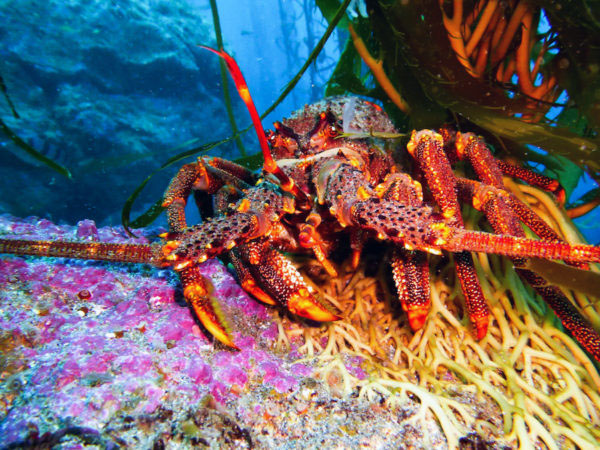
A beautiful and delicious Tristan lobster, Jasus Tristani and known locally as a Crawfish.
Photo by Katie Davis
Tristan da Cunha really is one of the key global hotspots of life—there is a most wonderful sense of the power of nature in this perfectly balanced ecosystem. Some of it tastes great, too!
Lobster fishing is the main income source here and the islanders’ management of this resource is an example that the whole world can learn from. Tristan lobster is some of the world’s most desirable and there is always pressure to catch more—but the islanders manage the catches very carefully and keep the fishery totally sustainable. They have their future generations and the health of our ocean in mind and of course we on the expedition also benefit as we’re having lobster tonight!
A Dark Ship
Report from Expedition Leader Paul Rose on 25th January 2017
On many of our expeditions we find a few seabirds on our deck in the morning and one of our important and fun pre-breakfast routines is to gather them up and send them on their way. But there are so many birds here at Tristan da Cunha that unless we use extreme measures at night we would wake up to a ship full of them.
So we are now a "dark ship."
Before dark we close every porthole and curtain, extinguish all outside lights and make sure that there is no light visible at all outside the ship. We do love these birds but we don’t want to be knee deep in them!

A broad-billed prion at Gough Island. One of the many birds that we do not want to crash land on our ship.
Photo by Andy Schofield
Visiting the home of the Tristan Albatross
Report by Jonathon Hall on 30th January 2017
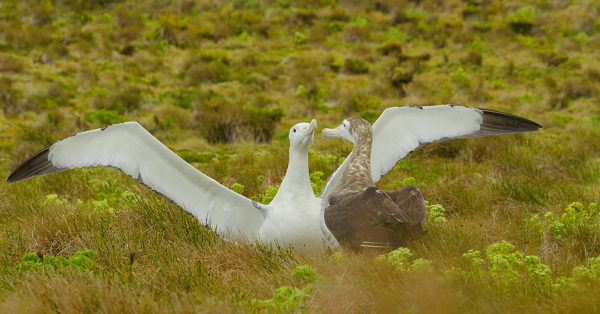
Male Tristan albatross courtship display on Gough Island. Photo by Brian Canavan
For years I’ve dreamed of visiting “Gonydale.” It’s a remote upland valley reached after a three-hour trek across rivers, beneath towering pinnacle cliffs and through thick lush ferns. It is a lost world, and one of the most magical and innocent places I’ve ever been. For it is here in this upland refuge that some of the last of the Tristan albatross (Diomedea dabbenena) breed. These giant and critically endangered birds are the ultimate ocean wanderers, travelling up to 1,000 km (620 miles) per day across the seas, yet up here in their secluded home they are being driven to extinction by the unlikeliest of predators—the largest house mice on the planet.
As we eventually reached the lip of Gonydale, our feet tired from tiptoeing around seemingly endless burrows of great shearwaters and other seabirds in the middle of the path, the vista opened up. It revealed the exhilarating sight of 40-50 of these enormous birds dotted around the valley floor and up its steep sides, their brilliant white breasts standing out clearly against the brown and yellow vegetation. With 3.5-m (11.5-ft) wingspans, they also wheeled above us like benign pterodactyls, the wind whistling off their wings as if a plane was flying low overhead. It’s courtship time, and the males were spreading their enormous wings, throwing their heads back, beaks to the sky, and emitting an incredible array of noises, from the gurgles of a percolating coffee machine to clicking and popping, which got our camerawoman running for her sound recording kit.
Totally unimpressed by human interlopers in their valley home, we were able to approach close and sit right by them as they tapped their enormous light-pink bills against each other and stared at us with their big black eyes. This naïveté to potential threats is the Achilles heel of these huge seabirds, as they simply don’t recognize land-based danger. Our mood was therefore tinged with sadness, knowing that only roughly 20 percent of the chicks which result from these beautiful displays will survive to fledge the nest.
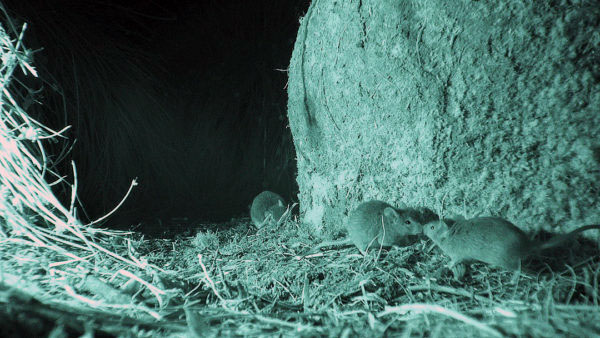
Gough mice waiting for their next meal at an Atlantic yellownose albatross nest pedestal.
Photo by Brian Canavan
There are introduced house mice on Gough, which have developed a taste for flesh and now kill and eat an estimated 600,000 seabird chicks every year. The Tristan albatross chicks, which are strong enough to survive on their pedestal nests through the gales and snowstorms of winter, are attacked where they sit by the carnivorous mice. Unable to fend them off, they are killed from a mixture of blood loss and exhaustion within four days. The species is therefore now critically endangered and threatened with extinction.
Preparing the Team - Protecting the Islands
Report from Expedition Leader Paul Rose on 13th January 2017
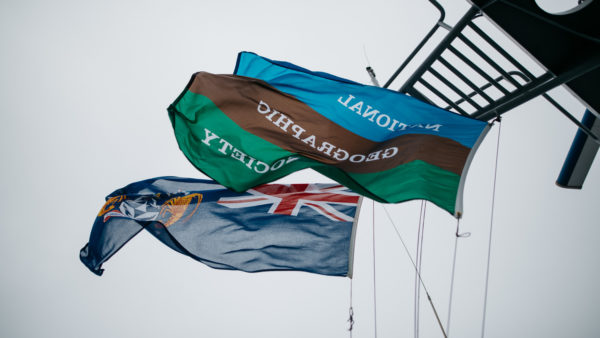
The flags of Tristan da Cunha and National Geographic proudly fly together above the SVS Grenville
en route to Tristan da Cunha. Photo by Roger Horrocks
It’s a big relief when our operational support systems are up and running. Our compressor system is commissioned and is pumping nitrox mix for the divers. The air bank is full and we’re now filling dive cylinders. Our two-man recompression chamber has been blown down three times and is ready to go.
The workboats are being washed and checked, the inflatables are inflated and for the first time in history I didn’t lose any skin assembling them.
GPSs are initialised, VHF radios are charged, and the Inmarsat system is up. It feels good to be connected again and the satellite phones are running hot with calls to the island finalising our plans.
The science systems have come to life. With help from the energy of the seabirds swooping along with us, our partners from the Royal Society for the Protection of Birds (RSPB) are rigging a few hundred bird tags for the Tristan Conservation Department to deploy so they can better understand where their key seabirds feed. I couldn’t help but notice that when the tags came out on deck, the albatrosses seemed to give them a highly suspicious glance.
The seal team has all of their gear along the starboard side—catch nets, backpacks, tagging gear, buckets, boots; it’s great stuff and looks as if it’s had an adventurous life on wild beaches. The drop-cameras are assembled, charged up, and ready. Pelagic camera rigs and the remote shallow water video systems are next in line. The hydro-acoustic unit and the shark tags are ready to go. The marine science dive team have their dive gear, measuring tapes, slates, and cameras all set up and are itching to get in the water.
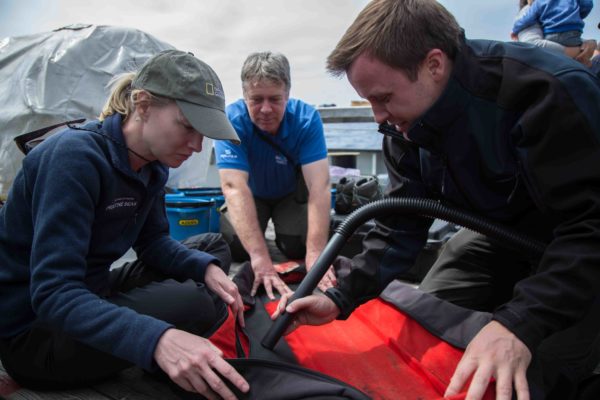
Members of the Pristine Seas team and the Royal Society for the Protection of Birds
meticulously clean equipment in preparation for arrival. Photo by Dan Myers.
The Most Important Work: Biosecurity
Because Tristan da Cunha is so remote and has a large number of endemic species (found nowhere else on Earth) it is especially vulnerable to invasive species. The beautifully balanced local ecosystem has no defence against aggressive alien plants and animals which can overrun the native life.
Sadly, a number of invasive species have already been introduced to the island. One of the most devastating is the common house mouse introduced to Gough Island World Heritage Site by sealers and which today kills an estimated 600,000 seabird chicks every year. Tristan da Cunha and the RSPB are preparing and fundraising for a hoped-for joint project in 2019 to restore this entire 25-square-mile island and undo the damage. This will be similar to a project carried out in South Georgia—another amazing South Atlantic British Territory which is hopefully now rodent-free.
The Tristan community are fully aware that invasive species are the number one threat to the environment upon which they depend, so they have been very proactive in developing new terrestrial biosecurity protocols for all visitors to their isolated ecosystems.
With all that firmly in our minds and overseen by Andy Schofield from RSPB, who is acting on behalf of Tristan da Cunha as an Environmental Officer, and Ian Lavarello the Chief Islander, we are enthusiastically working on our pre-arrival biosecurity measures. We are scrubbing boots, washing rain jackets, pants, rucksacks, cameras, tripods, and all equipment that is needed ashore. Velcro fasteners, pockets, the insides of bags, and all potential seed traps are being vacuumed clean. We are also carefully choosing the lunch food we will bring ashore—we cannot carry anything that has seeds such as apples, tomatoes, dried figs, etc.
We’re happy to work to this high standard as Tristan da Cunha is one of the least disturbed environments on Earth and we are honoured to be working alongside the Tristan islanders to learn from their experiences and join them in keeping it pristine for the future.
Tristan to Gough via Nightingale
Report from Expedition Leader Paul Rose on 23rd January 2017

Rockhopper penguins at Nightingale Island. Photo by Ryan Jenkinson
Gough Island, 225 miles to southwest of the main island of Tristan, had an almost mythical quality in our expedition planning: It’s hard to reach, hard to land on, and there is very little shelter because the winds are so strong that they whip completely around the island—and yet we absolutely had to get to Gough.
Our Tristan friends advised that we should sail for Gough as soon as the winds turned to the northwest. And so two days ago, when the wind quickly shifted, it was a lively time collecting Mike Fay from his Tristan botanical trek, the RSPB team from their beloved birds, the media team from filming the local fishermen, and the science team from their dives—all while making our ship ready for the passage.
We routed via Nightingale Island so that we could collect essential seal trackers, complete some albatross chick tagging, film the seals, albatrosses, rare plants, and Rockhopper penguins, and deliver Christmas mail to the two scientists at the research station. I fell in love with Nightingale Island and it became yet another remote spot where I would happily live for a year or two.

After an exciting passage Gough Island makes a dramatic and welcome appearance. Photo by Dave McAloney
Our passage here to Gough was idyllic (at first): The strong northwesterlies picked up a powerful swell and with dolphins for company we surfed through the night across the Antarctic Circumpolar Current into colder waters and the infamous Roaring Forties—a region of the Southern Ocean at 40° south with a fearsome reputation for storms and massive seas.
While we happily celebrated our arrival into new waters by fine-tuning our Gough work plan, the ship’s engine unhappily celebrated by stopping dead. It was a decidedly odd feeling to be one moment surfing down 12-foot following seas and then in the next moment to be silently adrift, the ship slowing and then lurching sideways onto the the waves and rolling heavily.
The sea temperature change was so dramatic that more water condensed out of the fuel than usual. This water got into the fuel system and stopped the engine. The excellent on-board engineering team only took two hours to drain the water and make repairs—but that was a long enough time wallowing around dead in the water to give us a little taste of the real power of the ocean. The ship coming alive when the engine started brought some cheers of relief and we spent the final 20 miles of the passage catching ever increasing glimpses of Gough through curtains of heavy cloud.
Expedition arrives at Tristan
Report from Expedition Leader Paul Rose
Our arrival here at Tristan da Cunha on 15th January 2017 could not have been better. From 60 miles away we could see the summit of the island soaring above the clouds. Only a few miles later we were enveloped in a fog so dense that we couldn't see from one end of our ship to the other. Guided by our radar we sailed slowly for two hours and then—at just two miles away—the island made a glorious, dramatic appearance.

Photo from Dan Myers from aboard the expedition ship SVS Grenville
on the approach to Tristan da Cunha from the east early in the evening of Sunday 15th January.
The Settlement Plain and cone of the 1961 volcano are visible right.
We feel as if we are part of the Tristan family: The expedition team and the Tristan Islanders became a single close family on our passage here, and as we helped unload their cargo from the storage hold and load it onto the barge their excitement at being home was tinged with a little sadness from us, as we love these people and we missed them aboard immediately.
Photograph from Kelly Burns showing SVS Grenville
anchored off Tristan on Monday 16th January, with a pontoon going alongside.
We are not short of ambition: We have twenty days to complete our comprehensive near-shore marine surveys, our deep and shallow water remote camera surveys, the botanical work, the bird studies, seal studies, hydro-acoustic recording, shark tagging, underwater filming, topside filming and sea-mount surveys on all four islands in the Tristan da Cunha group. It's very ambitious indeed and we are buzzing with the sense of challenge in this most beautiful and powerful setting.
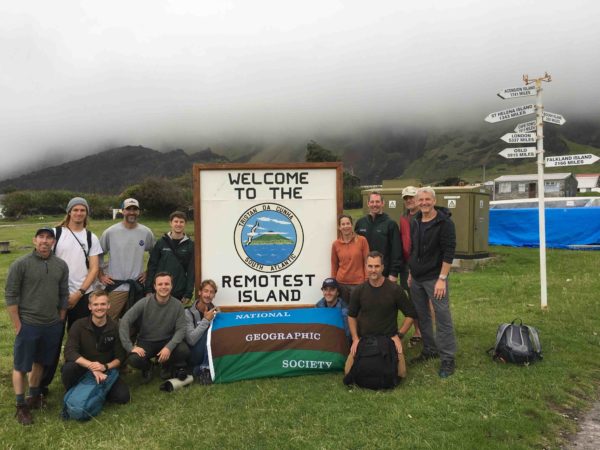
Photo from Katie Daves showing part of the Pristine Seas team gathered by the
famous 'Welcome' board by the Tristan Toursism Centre and Post Office on Monday 16th January.
The expedition team were able to come ashore on Monday morning to tour the Settlement. They returned to SVS Grenville before the ship's departure at noon to begin the expedition's work around the Tristan da Cunha Islands.
The Pristine Seas Expedition Team

The Pristine Seas National Geographic Tristan Team

Photo by Roger Horrocks shows expedition team members
gathered alongside SVS Grenville before embarkation on Sunday 8th January 2017.
Also in the photo are Tristan islanders returning home on the ship.
The Expedition Team List
Twenty Team members with names: role: and their institution
- Jenn Caselle; Chief Scientist; Marine Science Institute, University of California, Santa Barbara (UCSB).
- Katie Davis; Science diving; nearshore cameras; UCSB.
- Scott Hamilton; Science diving, invasive species; Moss Landing Marine Lab, California.
- Ryan Jenkinson; Science diving, lobsters; Humboldt State University.
- Doug Simpson; Science diving, outreach; University of Montana.
- Marthán Bester; Marine Mammals; Mammal Research Institute. University of Pretoria.
- Mia Wege; Marine Mammals; Mammal Research Institute, University of Pretoria.
- Mike Fay; Terrestrial science; National Geographic.
- Alan Turchik; Deepwater drop cameras; National Geographic.
- Chris Thompson; Pelagic and nearshore cameras; Centre for Marine Futures, University of Western Australia.
- Paul Rose; Expedition leader; National Geographic & the Royal Geographical Society.
- Dave McAloney; Diving / Medical / Logistics; National Geographic.
- Sam Dews; Boat driver / Logistics & science support.
- Alexandra Verville; Producer; National Geographic.
- Brian Canavan; Topside filming; National Geographic.
- Roger Horrocks; Underwater filming, National Geographic.
- Nathan Lefevre; Underwater camera assistant; National Geographic.
- Dan Myers; Intemational policy; NationaI Geographic.
- Jonathan Hall; Political liaison and birds; Head of UK Overseas Territories; Royal Society for the Protection of Birds (RSPB).
- Andy Schofield; Birds. terrestrial, local guidance and liaison; UK Overseas Territories Officer; RSPB.
The Expedition ship SVS Grenville and its voyage
|
|
About the expedition ship SVS Grenville and its voyage to the Tristan da Cunha Islands |
|
|
|
Photo from Nicky Swain showing SVS Grenville leaving Cape Town harbour on 8th January. |
|
|
| Photo from National Geographic taken from a drone over the expedition vessel SVS Grenville from team member Brian Canavan on 11th January 2017 |
|
The SVS Grenville is the National Geographic expedition ship for the 'Pristine Seas' project. It departed Cape Town during the afternoon of Sunday 8th January 2017 bound for Tristan da Cunha where it is expected to arrive a week later on 15th January. |
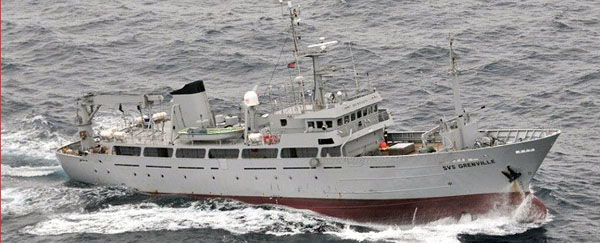 |
| The Expedition Ship SVS Grenville (Photo: National Geographic) |
| About SVS Grenville SVS Grenville is a Specialised Vessel Services offshore utility vessel with a length of 54m, a 9.4 m beam, 3.8 m draft and has is 459 gross tonnes. It has a 205-ton displacement and is powered by an Hanshin LH28L. The vessel has a range of 10,000 nm and a cruising speed of 10 knots. |
Aims and Objectives of the 'Pristine Seas' Expedition

|
Report from Expedition Leader Paul Rose |
|
Objectives of the expedition The goals of the Pristine Seas project are to find, survey, and help protect the last wild places in the ocean. The National Geographic’s Pristine Seas project, in collaboration with the Royal Society for the Protections of Birds (RSPB) and the Tristan da Cunha Government will conduct a 21-day expedition to Tristan da Cunha, Nightingale, Inaccessible and Gough islands in January-February 2017. Primary goals of the expedition are to conduct comprehensive quantitative surveys of the health of its largely unknown marine environment, and produce a documentary film to highlight this unique ecosystem and its people. The core research will include quantitative surveys of shallow flora and fauna using scuba diving and baited cameras, pelagic (open ocean) communities using baited stereo-cameras, and deep-sea habitats using National Geographic’s deep water drop-cameras. We will also use satellite tags to examine movement of apex predators such as sharks and tunas. Some filming will be done via small drone. The results of the expedition will be used to highlight the unique marine ecosystem of this archipelago, particularly the pelagic and deep sea environments, which are virtually unstudied. We will also partner with the Tristan island conservation and fisheries departments and RSPB on projects of mutual interest including: investigations of marine invasive species, penguin and albatross tagging studies, and lobster fisheries projects. Our work will complement ongoing research at Tristan da Cunha and we will share our data with all islanders as well as research partners currently conducting work on the islands. Our results are intended to help inform the Tristan Government about potential protection schemes that protect both important fisheries and unique biodiversity of the archipelago |

|
|
Benefits to the scientific community and the Tristan Government This expedition will establish a baseline for the marine ecosystems of Tristan da Cunha archipelago, which can be used to gauge the effects of future activities and management measures. The results from our work will provide valuable information in an area that is little known scientifically but may harbor high global biodiversity value. Our multidisciplinary and highly integrated assessment will provide a much more thorough understanding of how the entire ecosystem functions, therefore helping to inform better management of this unique area. The expedition will provide an invaluable springboard for information and data gathering to form a solid baseline to underpin further research to help inform Tristan’s future marine protection. Our work will complement and supplement studies of the marine flora and fauna from previous expeditions and research (see References). Our work will aid Tristan islanders in ongoing conservation work throughout the island group and in the future management of their crucial Tristan rock lobster fishery as well as other potential fisheries that the community may become more dependent upon in future. The expedition will also enable further knowledge transfer and capacity building with the Government Departments and community of Tristan da Cunha. |
 |
|
Expected results and products:
|
 |
Announcement of Tristan da Cunha Research Expedition 2017
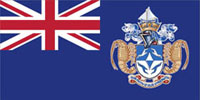 |
 |
 |
|
We are delighted to announce that in January 2017, the RSPB, Tristan da Cunha Government and National Geographic’s Pristine Seas team will be conducting a joint 5-week marine discovery expedition to the Tristan da Cunha archipelago. This expedition will help the Tristan community fulfil its ambition of 'establishing a regime for protecting the waters across the entire Tristan da Cunha Exclusive Economic Zone by 2020. This will be driven by the community, be science-led, and will meet both local economic and conservation needs. It will have the full financial support of the UK for management and enforcement, as part of the UK Government’s world-leading ‘Blue Belt’ commitment.' Significantly, the resulting protections will cover more than three quarters of a million square kilometres of rich ocean and also surround Gough Island World Heritage Site, described by the IUCN as ‘arguably the most important seabird island in the world’. The Tristan Government is very excited about this new partnership, and if you would like to hear more as the work unfolds, the Tristan Website will have a dedicated page on the expedition as it takes place. We are in direct contact with the National Geographic Pristine Seas Expedition Leader, the explorer and broadcaster Paul Rose who will keep us informed during the expedition. With a world-leading science team, underwater film-makers, deep-diving cameras, satellite trackers, a terrestrial film crew, expert local knowledge and plenty of places which no human eye has ever investigated before, the expedition hopes to both discover new species and records for Tristan, as well as to showcase the archipelago’s wildlife treasures to the world! Links: |
||


